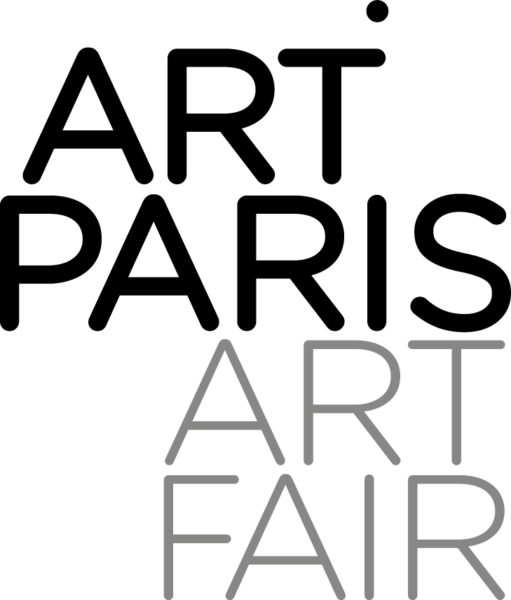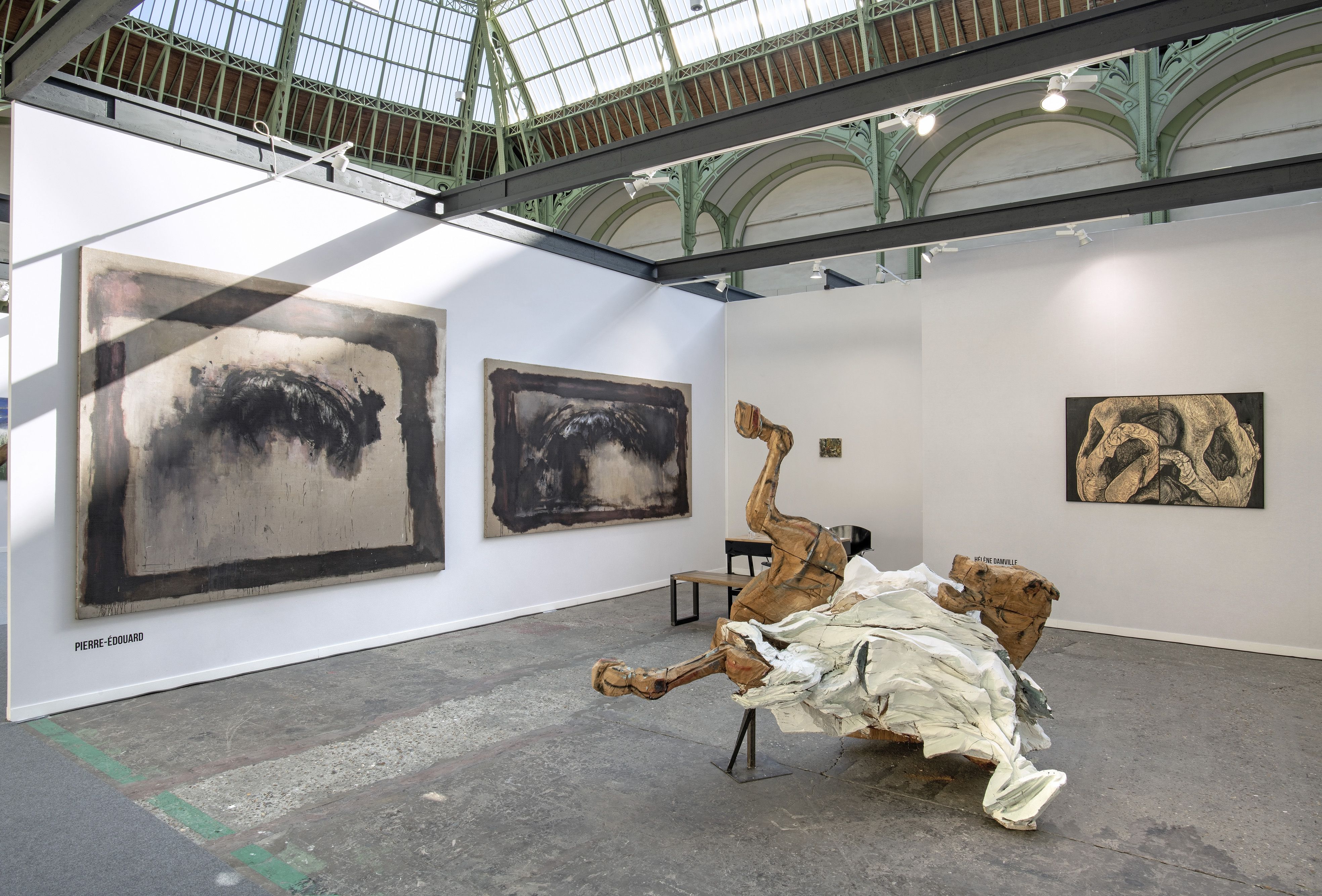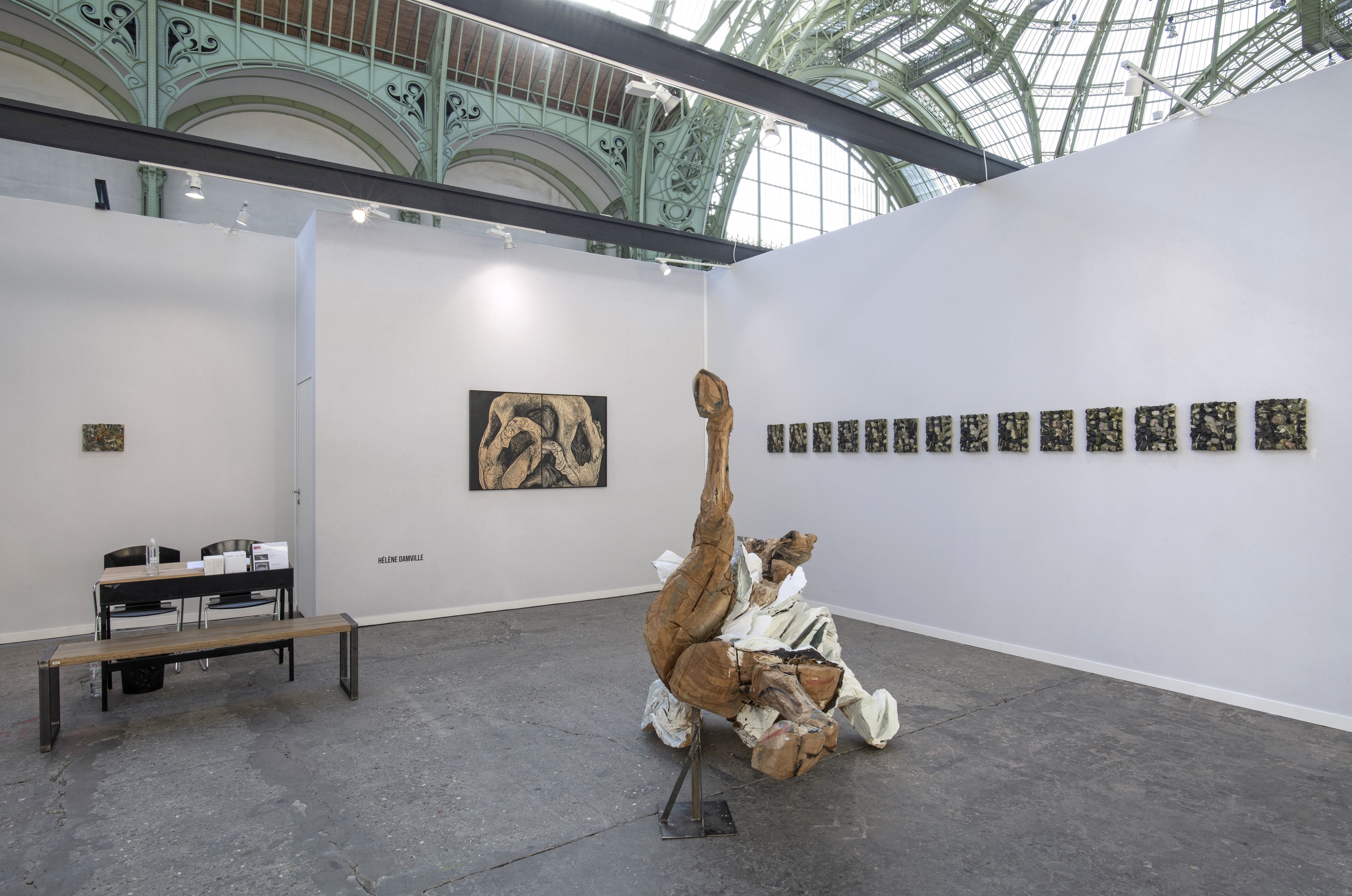For the 2020 edition of Art Paris, Loo & Lou Gallery is offering a glance of the French scene faithful to its
artistic program, with four artists: Pierre-Édouard, Cédric Le Corf, Hélène Damville and Paul de Pignol.
Though their practices are different, from paintings and drawings to sculptures and etchings, these
artists from different generations, with French origin or residing within the hexagon, create work
inspired by landscapes and have a certain fascination for the living.
CEDRIC LE CORF

Cedric Le Corf was born in 1985 in Bühl, near Baden-Baden (Germany), he lives and works in Brittany, in the Morbihan region. He graduated in 2009 with honours from the École Européenne Supérieure d’Art de Bretagne in Lorient.
The anatomical landscapes inspired by Jacques Fabien Gautier d’Agoty’s boards have resurfaced over time as an inspiration for Le Corf’s work. Little by little, a dismembered man is transformed into a landscape of a man. Humans, trees, and the earth all possess a kind of “skin” and with it, the ability to be flayed. Is it not true that a dissected body is merely a wide range of landscapes, full of mishaps, folds, and crevices? The slightest roughness in bone is reminiscent to the rocky landscapes of Patinir; the venous, arterial, or nervous network irrigates like rivers, plains, and estuaries; muscles, like the clay of Genesis, model gorges and mounds.
Using this metaphor, he uses plant roots as a landscape element to interlock bones, vertebrae, or joints made of porcelain. The root, in its etymological sense, is one element implanted inside another, much like the root of a tooth, a hair, or the dorsal root. It thus opposes the raw element of chaos to the mastery of creation, from roughness to polish, from decomposition to the inalterable, from the durability of art to the ephemeral man.
Imbued with the Rhineland and Armorican heritage, confronted with the pathos of Grünewald (Baldung Grien), the hanged men within “Des misères de la guerre” by Jacques Callot at “l’Ankou,” along with the macabre dances of Kernascléden, where the animate and the inanimate are mixed, to the horror of the mass graves of Sobibor, Le Corf tries, by attaching himself to a motif, to deafen the subject that the sculpture, the painting, or the engraving contains.
He has done several artist residencies, including the Dufraine Foundation in Chars, Académie des Beaux-Arts 2016-2018, the Spitzberg Expedition Residency 2017, Member of the Casa Velasquez in Madrid 2018-2019, and the Miro Foundation in Palma de Mallorca 2019.
He received the Georges Coulon Prize (sculpture) from the Institut de France, Académie des Beaux-Arts in 2017.
He has participated in numerous solo and group exhibitions in France, Germany, Spain and Belgium.
Private collection (Lambert collection)
Cedric Le Corf is represented by Loo and Lou Gallery, Paris
HÉLÈNE DAMVILLE

Born into a family of artists in Normandy, Hélène Damville has been practicing drawings inspired by nature since her youth.This passion for the observation of life (both fauna and flora) led her to explore the Natural History Museum of Paris where
she discovered Buffon and the naturalists. Copying works by her teachers, she familiarized herself with the complexity of skeletons and their articulations, as well as the networks and ramifications of the plant world. These dry elements represent life’s architecture as well as the traces left by passed lives. Parallel to her assiduous visits to museums, she completed her studies by following artistic anatomy classes and graduating with a Masters in Oriental Philosophy from the Sorbonne. In this environment of scientific, philosophic, and artistic analysis, she built up her portfolio of etchings.
The desire to be close to living matter pushed her to choose engraving as the main media in her research; Engraving, but more specifically directly carving on metal and wood. Through lines and vigorous strokes, the artist is able to translate the essence of life in her work. She was trained with a copper chisel by André Bongibault at the studio L’Estampe de Chaville, then later perfects ornamental engraving on metal at l’École Boulle. In her pieces, humans are rarely directly represented.
From engraving to tattooing
We find a natural extension in Damville’s pieces from working lines in the wood to the ancient art of tattooing. She is currently an apprentice in the Parisian tattoo salon belonging to Alessio Pariggiano. Since she loves working with organic material, Damville found the artistic niche she has been looking for.
- Pascal Hemery
From 2014 to 2015, she was an artist member of the French Academy in Madrid, Casa de Velazquez.
In 2017, she won the Jean Asselbergs Prize, Taylor Foundation.
PIERRE-ÉDOUARD

Pierre-Edouard was born in 1959.
His first series of drawings was created in the early 1980s and was shown by Claude Bernard in Paris. It is the series of "men on the ground". A vision which apprehends all forms from the angle of an uninterrupted modelling, using the almost musical shadow. Then came the paintings shown by Claude Bernard in 1989, a development of the theme of "men on the ground" and "characters to scale". Here we see a kind of deconstruction of the figure - the image is now incomplete. At the beginning of the 1990s, he tackled the theme of women in weightlessness in a series of sculptures that were shown in 1994. This theme of the body in horizontality and weightlessness will literally devour his work.
In 2004, he was awarded the 1st Prize of the Prince Pierre de Monaco Foundation and an exhibition followed the following year in the Principality. In 2010, he was elected member of the Académie des Beaux-Arts of the Institut de France.
He collaborates with the Gallery " Ditesheim & Mafféï fine Arts " (Switzerland) (www.galerieditesheim.ch/galerie/) which will hold an exhibition in 2011 and shows him regularly in fairs and exhibitions.
In 2009 he returned to painting. The works are parallel to the sculptures, but the formats are getting bigger. Pierre-Edouard ventures into a new space. Despite the non-figurative essence of these works, he continues to explore the theme of a body in suspense. A human body that resembles a gigantic sperm whale.
Pierre-Edouard's work as a whole is an articulation of the planes of space in a modulation without beginning or end. It is a work in suspense that questions the monumentality of form.
In 2013, he published the book "Baleines et Déesses" (Whales and Goddesses) with Editions William Blake and Co. A monograph of his engraved work, for which he wrote the text.
His works are in private collections in France, Switzerland, Belgium and the United States.
The Louis-Dreyfus Family Collection (www.ld-collection.org/ ) has a large number of drawings, paintings and sculptures.
PAUL DE PIGNOL

Paul de Pignol was born in Toulouse in 1965. He currently lives and works in Paris, France.
In 1984, he entered the National School of Fine Arts in Paris, where he worked in the studio of the painter, Pierre Carron. He created his first sculpture, inspired by the Venus of Lucas Cranach, entitled “Fille au Ballon” in 1989. Little by little, sculpture became integrated into his practice.
In in addition to the studio in Montigny-sur-Loing he used for his sculptures, Paul de Pignol decided to dedicate a specific workshop to drawing in Paris in 2010; he established a link between these disciplines a short time afterwards. Paul de Pignol’s drawings and sculputres are a plunge into an intimate essence of being. He focuses his work on feminine figures, linking them with universal themes of birth, life, and death.
Throughout his study of the female figure, he began questioning its function, weight, and composition, as well as its deconstruction and presence both inside and outside.
Paul de Pignol’s paintings are an extension of his work and research as a sculptor; his gestures are similar, wherein he erases matter in order to add light, stroke by stroke, giving his unveiled bodies a spectral presence.
Since 2017, after years of wandering, Paul de Pignol found pictoral language relative to his research.
One of his most recent exhibitions, “Né du limon,” is the result of this quest. With a fascination for landscapes, Paul de Pignol is inspired by the Fontainebleau forest that surrounds his studio. The idea that any life can birth from decay fascinate him, and he creates organic and living landscapes, where you can feel the turf and soil. We are close to the Golem.



